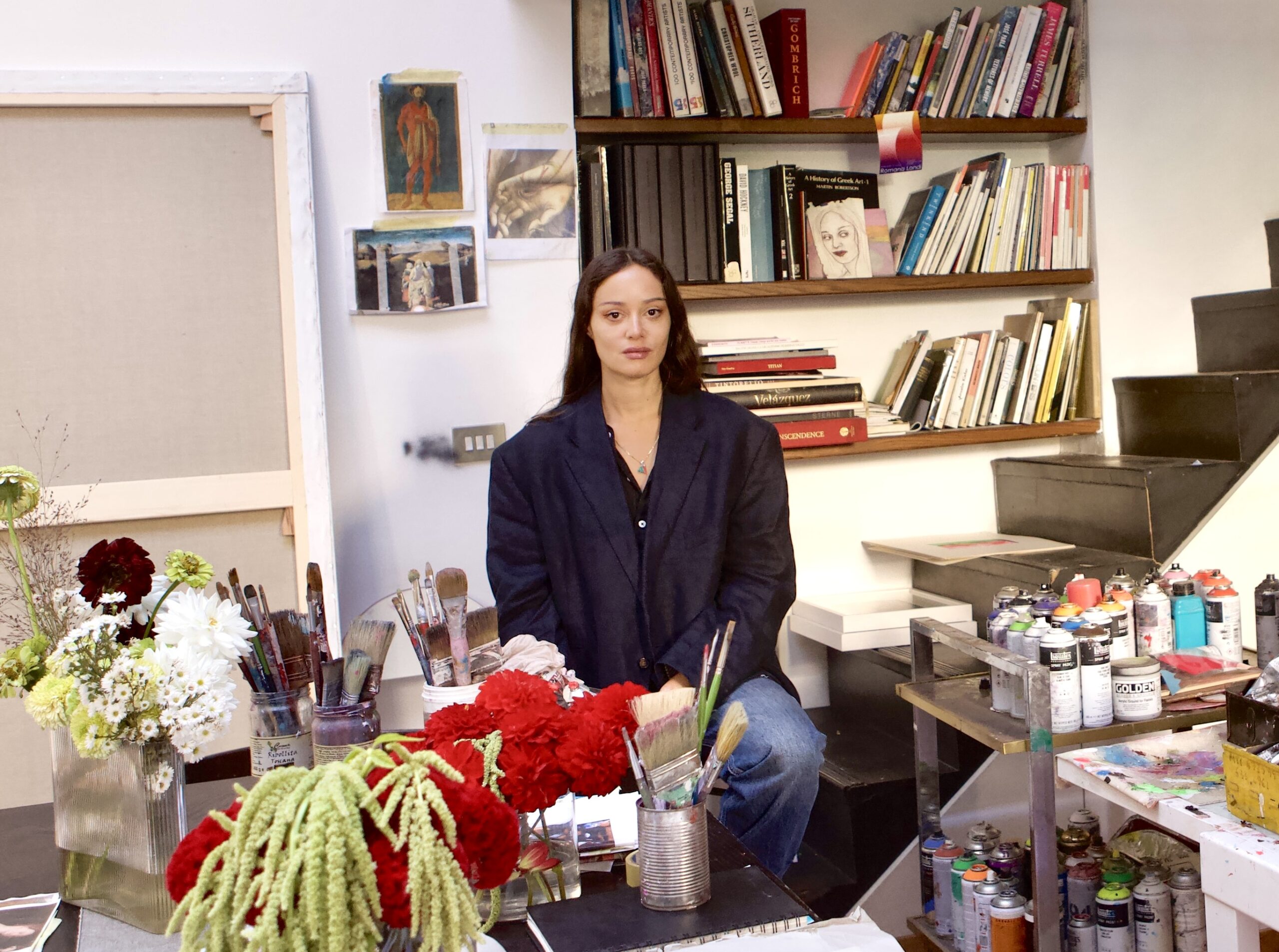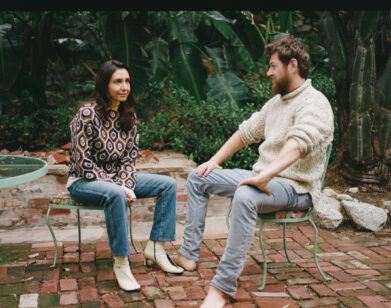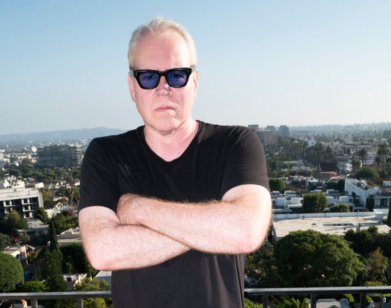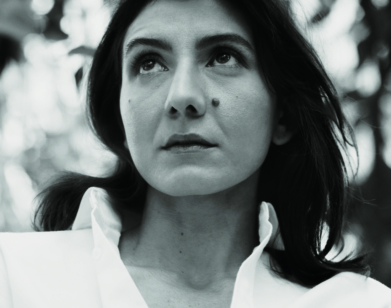MARTYRDOM
“Art Makes the Unbearable Bearable”: Romana Londi, in Conversation With Ottessa Moshfegh
The Italian painter Romana Londi’s obsession with the old masters isn’t typical. Growing up in Rome, she never expected to be so moved by the images of martyrs and Catholic relics that populate the city. “I wonder if it would be acceptable today to implant such sexually charged sculptures in the streets,” she comments. Years later, the artist’s fascination with depictions of martyrdom provide the explicit inspiration for her recent debut solo show with Nathalie Obadia. Titled WHAT IS YOUR SUBSTANCE, WHEREOF ARE YOU MADE, the series includes Londi’s representations of the martyred saint San Bartolomeo, who’s typically depicted in the process of being skinned alive before calmly wearing his own flesh as a dignified toga. And who better, of course, to discuss body horror and martyrdom with than the author Ottessa Moshfegh? When the two got together last month, they delved into the pleasure and pain of being alive and making art about the skin, an apparent organizing theme of Moshfegh’s forthcoming novel.—JULIETTE JEFFERS
———
OTTESSA MOSHFEGH: When I go home to Massachusetts, especially in the winter, I have a sharper sense of my own intelligence. My thinking is more analytical. It’s in the air, I think. The air is smarter there than in southern California. How is it for you now that you are back in Rome?
ROMANA LONDI: I love working in Rome, it’s a very generous city. It is very carnal and solemn and direct. My work is really absorbing. I have been a foreigner most of my life, and my mother was Irish, so being from elsewhere felt normal. But it is funny how I only perceived this since returning to Rome. I thought I could belong wherever I felt I belonged, but I can’t. Here, I recognize sounds and smells as mine. I wouldn’t say Rome is smart, but it does get straight to the point on all fronts, and it does contextualize situations quite easily. Every time I pass by the Pantheon, I feel humbled and reassured.
MOSHFEGH: I would imagine that being “home” would inspire a sense of ease, that ideas and feelings would be more within reach. And that might lead somewhere unexpected.
LONDI: In my work, I knew my obsession with composition and light came from growing up surrounded by old masters, but I really didn’t expect to be so affected by martyrdoms and relics and instead, I am. I find it all very daring, and I wonder if it would be acceptable today to implant such sexually charged sculptures in the streets: bloody heads cut by thorns and a mother crying over her son’s dead body? It’s like seeing it all for the first time. They made tons of work based on life’s struggle, life and death, death and life.
MOSHFEGH: The paintings in your latest show are all new works in your San Bartolomeo series, right?
LONDI: The most recent works are part of Jetlag, but since [coming back to] Rome, I became interested and worked on various depictions of San Bartolomeo, which is a brutal story but also a very humorous figure. Even dignified, one can say, as he was skinned alive and then shown wearing his skin as a toga. It feels human to cover one’s body, either with clothes or culture. I love that he is reclaiming his own skin, his vulnerabilities, his empathy. It made me think of the difference between human beings and being human, a valid question for today’s world’s struggles.
MOSHFEGH: The images you showed me when I visited you in Rome last summer impressed me particularly because San Bartolomeo appears so at ease. In my mind, he carries his skin draped over his arm as though it’s a luxurious cloak. He doesn’t appear to be in excruciating pain. Are there images of him demonstrating the removal of his skin? Can you narrate a bit of his story?
LONDI: San Bartolomeo has captivated me since I encountered Matteo di Giovanni’s depiction. As you say, he wears his skin as a cloak, he poses in a devilish manner, but he has verve. The saint has been historically depicted in the three different stages of his martyrdom, while being skinned (like Titian), then as a man holding his own skin (a type of representation common in Tuscany and which is famously seen in the Sistine Chapel painted by Michelangelo). And third, wearing his skin as a dress like Matteo Di Giovanni’s painting, which followed an old Umbrian iconographic tradition. The narrative relates to the same ongoing investigations in Jetlag. He is in fact the emblematic figure of it, someone who is ripped from his mortal form, disconnected to his environment, and who then re-appropriated his sentiencies, knowledge, humor, vulnerability, humanity.
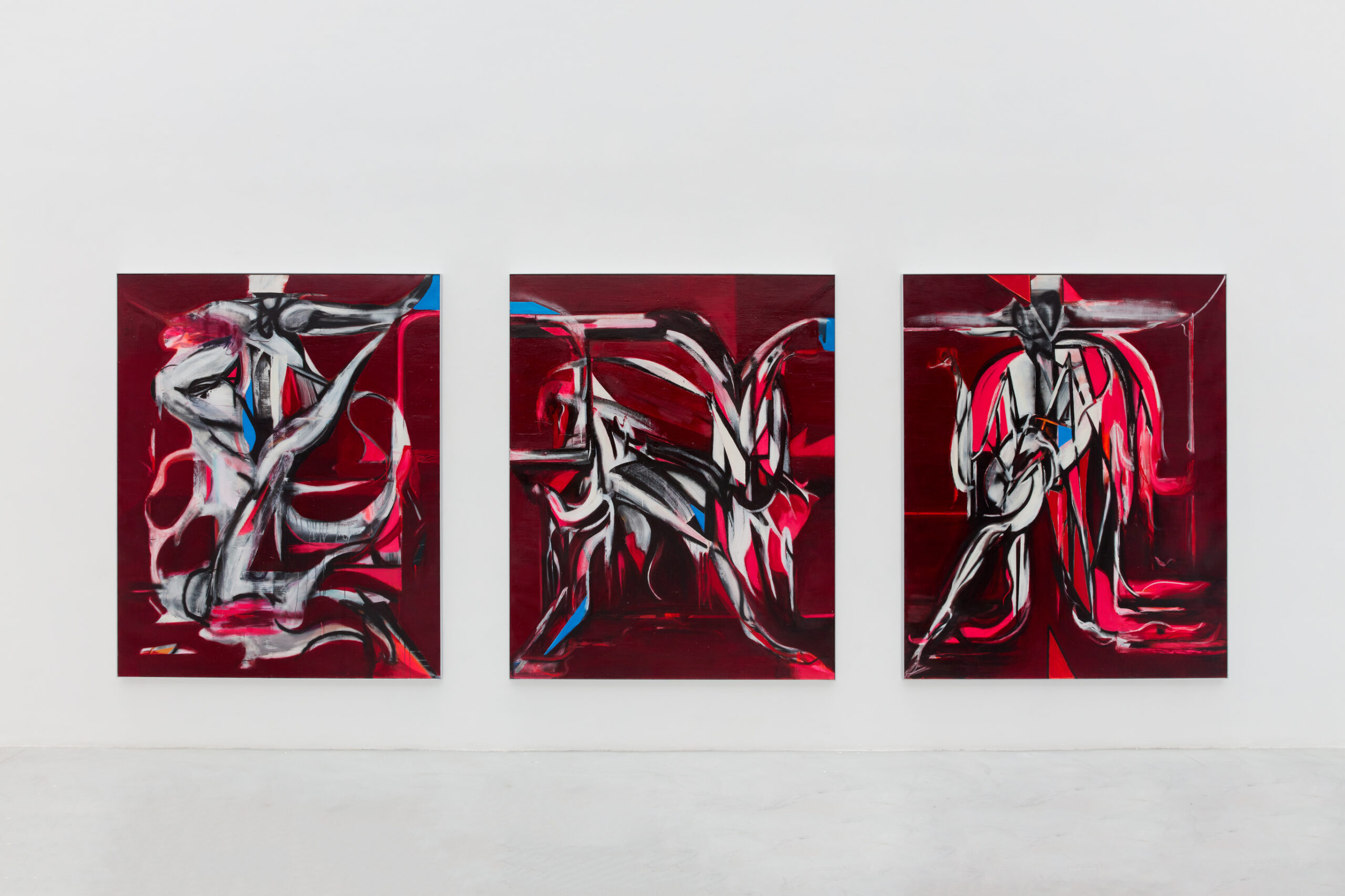
From left to right: STRIPPING IT (SAN BARTOLOMEO’S SKIN), 2023-2024; HOLDING IT (SAN BARTOLOMEO’S SKIN), 2023- 2024; WEARING IT, THE SUNS ARMOUR (SAN BARTOLOMEO’S SKIN), 2023-2024
Jetlag as a series is an investigation into the role of the body and of matter in a time of increased virtual connections, dominated by technological alienation, social upheaval, and personal fragmentation. Jetlag is the obvious metaphor for this, as after a long flight across different time zones, one is literally unsynchronised to the sun. I painted all three stages of his martyrdom. It’s not a triptych, but they belong together. One needed the other for me to be able to paint any of them. I began by painting the first stage, STRIPPING IT, and that was very expressive and bold and fast-paced and quite abrupt. I painted it from all sides so that gravity had multiple directions. I liked the word stripping rather than skinning because it’s more relatable. I then did HOLDING IT, which has taken me the longest between the three. It was very difficult, but I feel it’s more enigmatic, more distant, than the other two. And then, finally, I painted the third and last stage, WEARING IT, THE SUN’S ARMOUR. This work is more angular and neat, it’s sharp and futuristic, very self-resolved. It has less dripping and it presents a body rather than an action. The three stages feel very different to one another up close. You see that the choice of stroke is very different, and the three works evolve from expressive and bold into more controlled and self-assured. As with all my Jetlag series, I have also added a color-changing photochromic medium which is able to feel sunlight’s intensity and adapt to it. It reads its space, it converses with nature, and in this case, San Bartolomeo is being shielded by sunlight. The photochromic medium turns from red into black and it transforms his bare body into armor.
MOSHFEGH: I’m curious if you believe an artist must be uncomfortable to create the space to be inspired. I don’t quite know what I believe, because I’ve been uncomfortable my whole life—emotionally, I mean. And I’ve had chronic pain since age nine, so maybe discomfort is just the water I’m swimming in. But is it this discomfort that forces me into my imagination, to pursue what is beyond me? I suppose this is my clumsy way of also asking you how you relate to Saint Bartholomew. Have you skinned yourself lately?
LONDI: It is a very difficult question. To make good art, one needs as many instruments as possible. Not physical, but I mean knowledge, which is fed by empathy. I was able to persevere with my work all these years, and through different ways of working, because I do it as a way of navigating my own struggles and, of course, the world. Art makes the unbearable bearable. But talent and sensibility is random. Suffering does not preclude the ability to portray it or best transform it into something more than that. I think courage has to be aligned with depth. Imagination is a muscle, but there is a skeleton that carries it.
MOSHFEGH: I get that.
LONDI: Painting is very difficult for me. I feel I’m not clear when I begin, and I am rarely faithful to what I want to do. In the end, the painting is more important than my ideas. How do you choose your subjects, and how clear are these when you begin to write? Are you faithful to them in the process of writing?
MOSHFEGH: The first few visions of a character and their story are always sacred stones. They are immovable and they root the book in its form and purpose. But they’re not always obvious to me. I mean, they may be very clear ideas, but it takes me a lot of work to figure out what they mean to me. For instance, in the opening paragraph of this new book, the character’s apartment is described as looking like the set of a soap opera. It took me about a year to understand why I had put in that descriptive metaphor. And only now am I realizing that the structure of the novel functions like a season of bad episodic television, like a soap opera. Between then and now, the not-knowing and the knowing, there’s a lot of swimming out into the water just to see what it feels like, building muscles around the mysterious skeleton, I guess. I write a lot of stuff I don’t use. And other times I think I’ve wasted a lot of time writing things that are banal and strategic. Like, “He went here and he did this,” over and over again. It’s hard to accept that that is part of the book too, these banal elements. I have such an intense appreciation for how much you feel and know about yourself. And then the very simple part of me wants to ask you more about how you make decisions as a painter, how you grew to hate details, why you think figurative art is too easy.
LONDI: Actually, for me, there is no distinction between figurative painting and abstract painting. I read them both as lines, layers, liquid, matte, hot and cold. Maybe I hate anything too derivative and self-aware. My relationship with each painting is more akin to how you write short stories. It’s bombastic and really dense. My work, and painting in general, is really a struggle between the material world and everything that exists so well and dominantly in every other way of existing. For years, I painted in a very performative way, even ritualistic, so even if I have my “sacred stones,” as you said, I also just have to do it in order to truly understand the nature of my intentions. It’s certainly about testing sensibility, not the validation of an aesthetic. The aesthetic is the vehicle, not the journey. I have a lot of questions to ask you on this new book, and the way you are working on it, but I would hate to be questioned while painting a new series. Do you feel the same way?
MOSHFEGH: I used to be very terrified of talking about a project while it was mid-stream. It was my superstition that if I spoke about the work, it would fall apart, as though exposing it to air would cause it to oxidize and deteriorate. The silent trap of my own mind was the only safe place a process could live. Back when I was focusing on short stories, this attitude really worked: my process was so interior, unconscious, and it was pretty easy to keep quiet. I wasn’t figuring out big plots or writing and erasing hundreds of pages. It was more like painting fine china. But as I started writing novels, my life, my process, and my work became so intertwined in that creepy, uncanny way that happens and I had to start talking about it. I needed the oxygen, as it turns out. And now, I have a different philosophy about exposure: if I talk about an idea and it falls apart, it wasn’t good or right or fully formed yet. So actually, talking helps me now. It also forces me to put the work in terms that translate. So I can see the intelligence inside the project—not my own intelligence, but how a piece is wired. It’s not just an aesthetic game, you know?
LONDI: I agree that one must be able to discuss the work, yet what I seek is to activate my viewer. Seeing is a passive state, the neutral state of being awake, but looking requires intention. I like contemplation, I need ambivalence. These are very personal and private experiences, which cease if I try to wire them too soon.
MOSHFEGH: I love how you talked about San Bartolomeo and the space he creates, the merciful irony in his eye. Do you feel that you live in the same realm as him? Do you live in the same realm as your paintings? Who is your see-er?
LONDI: My see-er is you, artists I admire, writers, musicians, intellectuals, brilliant minds and brilliant hearts, humans I empathize with, moments in life that have shaped me and that I feel I’m constantly thrown back into. Or, of course, the see-er is very much the painting itself, as if it can validate all I have just mentioned, or allow these to transform, survive, live again, and forever, not unlike the way you describe writing for the protagonist of your story. I noticed that to many, my practice has changed drastically, yet I feel the atmosphere you ask if I’m part of and that is embodied by San Bartolomeo. The skin is ever-present. It’s certainly about sensibility, one which I notice you have yourself throughout your books no matter how different the stories are from one another.
MOSHFEGH: My new novel is all about skin, by the way. It just occurred to me now as we’re talking that this matter of the skin is something very present in both of our imaginations. My whole book is about a boy who finds spiritual relief in cutting through his own skin as a kind of misleading celebration of life. I’m setting the story in a country that resembles England, a place, in my experience, where social boundaries and the emotional distance between people are far more well-defined than in the US. So I’m writing it in a detached British accent, but I am reading it with the neediness of an American. Perhaps this only makes sense to me. Do you feel there is a correct way to look at your San Bartolomeo paintings?
LONDI: It makes complete sense. I think my recent work is a continuation of or is aware of many influences—from futurism to metaphysics to medieval painting to abstraction to computer generated art—but I’m not interested in referencing art history as a rebus game. Many of these connections or references are not deliberate; they are unavoidable, and I notice them later. Also, it would take real art knowledge to access it, to read it in these terms. I think my gallerist [Galerie Natahlie Obadia] was one of the very few who knew immediately what had influenced me. Having said this, there is no wrong way of seeing a painting. But there is a wrong place, like the iPhone screen. My recent exhibition title is a question that validates a conversation being placed through my work: WHAT IS YOUR SUBSTANCE, WHEREOF ARE YOU MADE (that millions of strange shadows on you tend)? I was inspired by my biggest audience as of today, and that is no longer a gallery visitor or a critic but an algorithm. It’s a line from a sonnet by Shakespeare, but I came across it reading Jeanette Winterson’s book Night Side of the River. To ask what one is made of feels plausible as metaverse, and everything we are relying on to survive and to strive and to explore is not under the sun. It has no substance or shadows. I wonder how our senses will evolve now that we need them less, now that everything is becoming sentient and we rely on its sentiency. There is a line I love in Mon oncle d’Amérique. It says, “A person is a memory which acts,” and that is by definition how AI is developing, a sequence of actions turning into a set recipe. Maybe that’s why we are so interested in skin. It’s the fallibility and the vulnerability, the pleasure and the pain of being alive before something which is alive back at you. The definition, per se, for something to be considered alive and not simply life-like.

